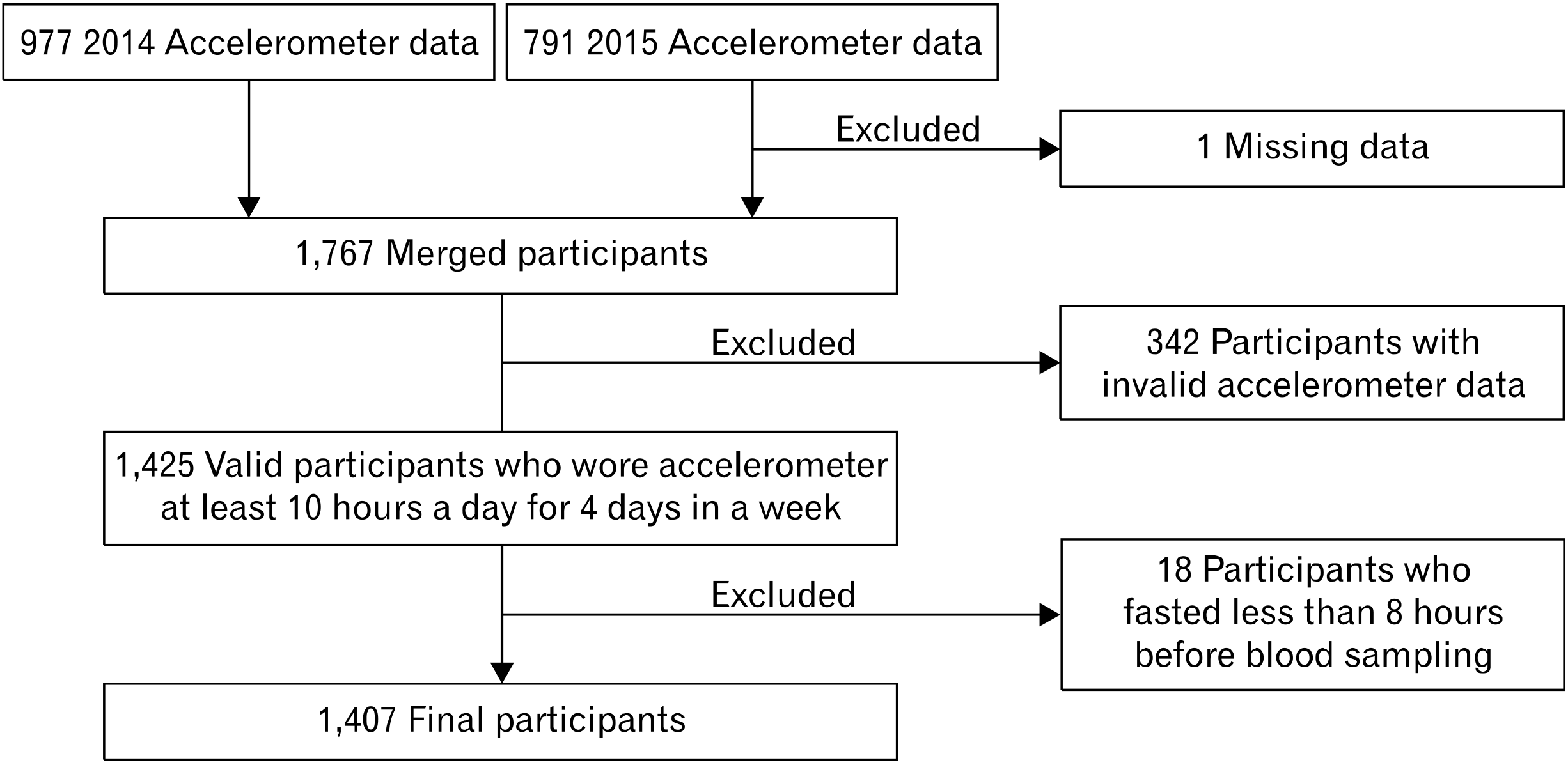2. American College of Sports Medicine. 2013. ACSM's guidelines for exercise testing and prescription. Lippincott Williams & Wilkins;Indianapolis (IN):
3. Carter S, Hartman Y, Holder S, Thijssen DH, Hopkins ND. 2017; Sedentary behavior and cardiovascular disease risk: mediating mechanisms. Exerc Sport Sci Rev. 45:80–6. DOI:
10.1249/JES.0000000000000106. PMID:
28118158.

4. Healy GN, Dunstan DW, Salmon J, Shaw JE, Zimmet PZ, Owen N. 2008; Television time and continuous metabolic risk in physically active adults. Med Sci Sports Exerc. 40:639–45. DOI:
10.1249/MSS.0b013e3181607421. PMID:
18317383.

5. Healy GN, Matthews CE, Dunstan DW, Winkler EA, Owen N. 2011; Sedentary time and cardio-metabolic biomarkers in US adults: NHANES 2003-06. Eur Heart J. 32:590–7. DOI:
10.1093/eurheartj/ehq451. PMID:
21224291. PMCID:
PMC3634159.

6. Park JH, Joh HK, Lee GS, et al. 2018; Association between sedentary time and cardiovascular risk factors in Korean adults. Korean J Fam Med. 39:29–36. DOI:
10.4082/kjfm.2018.39.1.29. PMID:
29383209. PMCID:
PMC5788843.

7. Korea Centers for Disease Control and Prevention. KNHANES regulation for using of accelerometer raw data Ⅵ (2014-2015) [Internet]. Korea Centers for Disease Control and Prevention;Cheongju: Available from:
https://knhanes.cdc.go.kr/knhanes/sub03/sub03_02_02.do. cited 2020 Jul 1.
8. Lee H, Lee M, Choi J, Oh K, Kim Y, Kim S. 2018; KNHANES actigraph raw data processing. Korean J Meas Eval Phys Educ Sport Sci. 20:83–94. DOI:
10.35159/kjss.2018.10.27.5.83.
9. Troiano RP, Berrigan D, Dodd KW, Masse LC, Tilert T, McDowell M. 2008; Physical activity in the United States measured by accelerometer. Med Sci Sports Exerc. 40:181–8. DOI:
10.1249/mss.0b013e31815a51b3. PMID:
18091006.

10. Atienza AA, Moser RP, Perna F, et al. 2011; Self-reported and objectively measured activity related to biomarkers using NHANES. Med Sci Sports Exerc. 43:815–21. DOI:
10.1249/MSS.0b013e3181fdfc32. PMID:
20962693.

11. Tucker JM, Welk GJ, Beyler NK, Kim Y. 2016; Associations between physical activity and metabolic syndrome: comparison between self-report and accelerometry. Am J Health Promot. 30:155–62. DOI:
10.4278/ajhp.121127-QUAN-576. PMID:
25806568.

12. Lee M. 2016. A study of physical activity assessment analytic guidelines of Korean National Health and Nutrition Examination Survey. Korea Centers for Disease Control and Prevention;Cheongju:
13. Korea Centers for Disease Control and Prevention. KNHANES regulation for using of raw data 6th (2013-2015) [Internet]. Korea Centers for Disease Control and Prevention;Cheongju: Available from:
https://knhanes.cdc.go.kr/knhanes/sub03/sub03_06_02.do. cited 2020 Jul 1.
14. Healy GN, Dunstan DW, Salmon J, et al. 2008; Breaks in sedentary time: beneficial associations with metabolic risk. Diabetes Care. 31:661–6. DOI:
10.2337/dc07-2046. PMID:
18252901.

15. Friedewald WT, Levy RI, Fredrickson DS. 1972; Estimation of the concentration of low-density lipoprotein cholesterol in plasma, without use of the preparative ultracentrifuge. Clin Chem. 18:499–502. DOI:
10.1093/clinchem/18.6.499. PMID:
4337382.

17. Korea Centers for Disease Control and Prevention, Korean Academy of Medical Sciences. Standard of diabetes [Internet]. Korea Centers for Disease Control and Prevention, Korean Academy of Medical Sciences;Seoul: Available from: health.cdc.go.kr/health/HealthInfoArea/ HealthInfo/View.do?idx=2160&page=1&sortType=viewcount&dept=&category_code=&category=1&searchField=titleAndSummary&searchWord=%EB%8B%B9%EB%87%A8&dateSelect=1&fromDate=&toDate=. cited 2020 Jul 1.
18. Korea Centers for Disease Control and Prevention, Korean Academy of Medical Sciences. Standard of dyslipidemia [Internet]. Korea Centers for Disease Control and Prevention, Korean Academy of Medical Sciences;Seoul: Available from: health.cdc.go.kr/health/HealthInfoArea/ HealthInfo/View.do?idx=160&page=1&sortType=viewcount&dept=&category_code=&category=1&searchField=title&searchWord=%EC%9D%B4%EC%83%81%EC%A7%80%EC%A7%88&dateSelect=1&fromDate=&toDate=#tagID2. cited 2020 Jul 1.
19. Ford ES, Caspersen CJ. 2012; Sedentary behaviour and cardiovascular disease: a review of prospective studies. Int J Epidemiol. 41:1338–53. DOI:
10.1093/ije/dys078. PMID:
22634869. PMCID:
PMC4582407.

20. Clark BK, Sugiyama T, Healy GN, Salmon J, Dunstan DW, Owen N. 2009; Validity and reliability of measures of television viewing time and other non-occupational sedentary behaviour of adults: a review. Obes Rev. 10:7–16. DOI:
10.1111/j.1467-789X.2008.00508.x. PMID:
18631161.

21. Clark BK, Healy GN, Winkler EA, et al. 2011; Relationship of television time with accelerometer-derived sedentary time: NHANES. Med Sci Sports Exerc. 43:822–8. DOI:
10.1249/MSS.0b013e3182019510. PMID:
20980928.
22. Thorp AA, Healy GN, Winkler E, et al. 2012; Prolonged sedentary time and physical activity in workplace and non-work contexts: a cross-sectional study of office, customer service and call centre employees. Int J Behav Nutr Phys Act. 9:128. DOI:
10.1186/1479-5868-9-128. PMID:
23101767. PMCID:
PMC3546308.

23. Brocklebank LA, Falconer CL, Page AS, Perry R, Cooper AR. 2015; Accelerometer-measured sedentary time and cardiometabolic biomarkers: a systematic review. Prev Med. 76:92–102. DOI:
10.1016/j.ypmed.2015.04.013. PMID:
25913420.

24. Leon-Latre M, Moreno-Franco B, Andres-Esteban EM, et al. 2014; Sedentary lifestyle and its relation to cardiovascular risk factors, insulin resistance and inflammatory profile. Rev Esp Cardiol (Engl Ed). 67:449–55. DOI:
10.1016/j.rec.2013.10.015. PMID:
24863593.
25. Altenburg TM, Lakerveld J, Bot SD, Nijpels G, Chinapaw MJ. 2014; The prospective relationship between sedentary time and cardiometabolic health in adults at increased cardiometabolic risk: the Hoorn Prevention Study. Int J Behav Nutr Phys Act. 11:90. DOI:
10.1186/s12966-014-0090-3. PMID:
25027974. PMCID:
PMC4132212.

26. Hamilton MT, Hamilton DG, Zderic TW. 2007; Role of low energy expenditure and sitting in obesity, metabolic syndrome, type 2 diabetes, and cardiovascular disease. Diabetes. 56:2655–67. DOI:
10.2337/db07-0882. PMID:
17827399.

27. Parsons TJ, Sartini C, Ellins EA, et al. 2016; Objectively measured physical activity and sedentary behaviour and ankle brachial index: cross-sectional and longitudinal associations in older men. Atherosclerosis. 247:28–34. DOI:
10.1016/j.atherosclerosis.2016.01.038. PMID:
26854973. PMCID:
PMC4819952.

28. Huynh QL, Blizzard CL, Sharman JE, Magnussen CG, Dwyer T, Venn AJ. 2014; The cross-sectional association of sitting time with carotid artery stiffness in young adults. BMJ Open. 4:e004384. DOI:
10.1136/bmjopen-2013-004384. PMID:
24604484. PMCID:
PMC3948580.

29. Kozakova M, Palombo C, Morizzo C, et al. 2010; Effect of sedentary behaviour and vigorous physical activity on segment-specific carotid wall thickness and its progression in a healthy population. Eur Heart J. 31:1511–9. DOI:
10.1093/eurheartj/ehq092. PMID:
20400760.





 PDF
PDF Citation
Citation Print
Print




 XML Download
XML Download